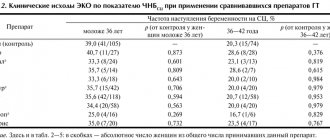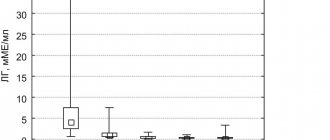Gonadotropin analysis
Human chorionic gonadotropin. When a test is prescribed, how to prepare for the procedure, how to interpret the results.
Human chorionic gonadotropin is a hormone that is produced by the outer membrane of the embryo during a woman’s pregnancy. The substance is detected in the patient’s blood and urine.
HCG consists of two parts - alpha and beta. The beta subunit is unique and is used to monitor the progress of pregnancy. By determining the level of hCG, pregnancy can be diagnosed as early as 6-8 days after conception.
HCG plays a vital role during pregnancy - it affects the development of the fetus and embryo, stimulates the synthesis of hormones by ovarian cells, helps maintain the functional activity of the placenta, and ensures a successful pregnancy.
If hCG is introduced into the body of a non-pregnant woman artificially, this will lead to ovulation, the synthesis of sex hormones necessary for conceiving a child. If you administer the hormone to a man, it will enhance the formation of seminal fluid and activate the production of gonadosteroids.
HCG plays a special role in early pregnancy. The hormone supports the production of hormones necessary to maintain pregnancy, and in the male fetus it stimulates the cells that are responsible for the formation and development of male characteristics.
Interpretation of the results of a blood test for hCG
HCG is below normal If the level of hCG is below normal (or expectations), then this may indicate such dangerous pathologies as:
ectopic pregnancy; frozen pregnancy (the fetus has stopped developing); risk of miscarriage; delay in fetal development; impaired development of the placenta; in the second and third trimesters, a decrease in hCG levels may be a consequence of fetal death. If you receive a result that goes beyond the reference values, you should not be immediately alarmed. Perhaps you simply misjudged how far along you are in your pregnancy. In any case, the doctor will prescribe a repeat analysis and additional studies (in particular, ultrasound); A diagnosis cannot be made based on one analysis.
HCG is higher than normal If the test shows the level of hCG in the blood is higher than normal, this may indicate:
multiple pregnancy (in this case, the hCG content will increase in proportion to the number of fetuses); diabetes; fetal pathology (including Down syndrome); toxicosis. HCG blood test for men and non-pregnant women HCG blood test can be prescribed for non-pregnant women and even men. This is done when diagnosing diseases such as chorionepithelioma (in women) and neoplasms in the testicle (in men).
Normally, in men and non-pregnant women, the level of hCG in the blood should be <5 mU/ml.
Chorionic gonadotropin (vial 5000 units No. 5)
A country
Russia
The country of production may vary depending on the batch of goods. Please check with the operator for detailed information when confirming your order.
Active substance
Chorionic gonadotropin
Compound
Vial 1000 IU
Human chorionic gonadotropin 5000 IU.
pharmachologic effect
Gonadotropic hormone. Produced by the human placenta and excreted in urine, from where it can be extracted and purified. Stimulates the production of progesterone by the corpus luteum and supports the development of the placenta. It has a gonadotropic effect, predominantly luteinizing. In women, the drug causes ovulation and stimulates the synthesis of estrogen and progesterone. In men, it stimulates spermatogenesis and the production of sex steroids.
Indications for use
For women: induction of ovulation after stimulation of follicular growth; maintaining the function of the corpus luteum of the ovary in patients with luteal phase deficiency. For boys and men: cryptorchidism (ectopia, retention of the testicles in the abdominal cavity or in the inguinal canal); delayed puberty; hypogonadotropic hypogonadism (in combination with human menopausal gonadotropin preparations); when conducting a differential diagnostic test for anorchism and cryptorchidism in boys; when performing a Leydig functional test to assess testicular function in hypogonadotropic hypogonadism before starting long-term stimulating treatment.
Mode of application
Individual, depending on the indications and treatment regimen.
Side effect
From the endocrine system in women: possible development of ovarian hyperstimulation syndrome, accompanied by the development of ovarian cysts with the risk of their rupture, ascites, hydrothorax and the risk of thromboembolism. From the endocrine system in boys and men: possible temporary reversible enlargement of the mammary glands, prostate gland, water and electrolyte retention, acne vulgaris; in boys, behavioral changes similar to those observed during the first phase of puberty are possible, which disappear after the end of treatment.
Contraindications
Tumors of various localizations, dependent on sex hormones; organically caused cryptorchidism (inguinal hernia, consequences of surgical interventions in the groin area, abnormal position of the testicles) in boys and men; hypersensitivity to human chorionic gonadotropin. Use during pregnancy and breastfeeding There is an increased risk of miscarriage and/or multiple pregnancies after treatment with gonadotropins.
special instructions
Long-term use is not recommended due to the possible formation of antibodies that reduce the effectiveness of treatment. If ovarian hyperstimulation syndrome develops, use should be discontinued.
Dispensing conditions in pharmacies
On prescription
Gonadotropin. Interpretation of a blood test for hCG
The level of hCG in the blood is individual for different categories of patients. You can independently interpret the results of the analysis, but in this case their reliability rests solely on your shoulders. Therefore, in order to decipher the results and subsequently diagnose certain pathologies in the event of deviations from the norm, it is necessary to contact a specialized specialist.
HCG levels are influenced by factors such as gender, age and pregnancy. This level fluctuates significantly throughout pregnancy.
It is also worth noting that most laboratories use different equipment. Therefore, the norms of different research centers may differ. If you want to get the most reliable result, it is better to contact trusted clinics. It is also best to interpret the results of the study at the medical institution where you took the test.
If the analysis showed an increased level of hCG in the blood of a man or a non-pregnant woman, this may indicate a number of serious diseases: oncology of the intestines, lungs, kidneys, uterus, ovary and a number of other organs. In addition, an increase in hCG is usually observed within a few days after termination of pregnancy, as well as during the entire period of taking medications containing hCG.
If we are talking about an increased level of hCG in the blood of a pregnant woman, this may indicate:
- The fact that the pregnancy is multiple;
- Presence of diabetes mellitus in pregnant women;
- Development of gestosis, early toxicosis;
- The fact that the pregnancy has already been postponed;
- The fetus has various chromosomal abnormalities.
If the level of hCG in the blood of a pregnant woman is low, this is an alarming sign in which it is necessary to immediately consult a doctor. Significant deviations from the norm may indicate that the pregnancy is ectopic or frozen, there is a threat of miscarriage, placental insufficiency is present, the pregnancy is very post-term or the fetus died in the later stages.
Chorionic gonadotropin, lyophilisate for intramuscular injection, 5000 IU vial. (+ NaCl solution), 5 pcs.
After adding the solvent to the lyophilisate, the reconstituted solution of human chorionic gonadotropin is administered intramuscularly, slowly. The prepared solution cannot be stored, since further preservation of the sterility of the solution is not guaranteed. The dosages indicated are approximate; treatment should be adjusted by the doctor individually depending on the desired response to the drug.
Among women
For anovulatory cycles, human chorionic gonadotropin is prescribed, starting from the 10th–12th day of the menstrual cycle, 3000 IU 2–3 times with an interval of 2–3 days or 1500 IU 6–7 times every other day.
To maintain the corpus luteum phase, two to three repeated injections of the drug at a dose of 1500 IU to 5000 IU each can be given within 9 days after ovulation or embryo transfer (for example, on days 3, 6 and 9 after ovulation induction).
In men and boys
For hypogonadotropic hypogonadism - 1000–2000 IU of the drug 2–3 times a week. In case of infertility, it is possible to combine human chorionic gonadotropin with an additional drug containing follitropin (follicle-stimulating hormone) 2-3 times a week. The course of treatment should continue for at least 3 months before any improvement in spermatogenesis can be expected. Testosterone replacement therapy must be suspended during this treatment. When improvement in spermatogenesis is achieved, in some cases, isolated use of human chorionic gonadotropin is sufficient to maintain it.
For delayed puberty caused by insufficiency of the gonadotropic function of the pituitary gland - 1500 IU 2-3 times a week. The course of treatment is at least 6 months.
For cryptorchidism not caused by anatomical obstruction:
- aged 3 to 6 years - 500-1000 IU twice a week for 6 weeks;
- over the age of 6 years - 1500 IU twice a week for 6 weeks.
The course of treatment can be repeated if necessary.
In case of insufficiency of spermatogenesis, oligoasthenospermia, azoospermia, 500 IU is prescribed in combination with menotropin (75 IU follicle-stimulating hormone + 75 IU luteinizing hormone) daily, or 2000 IU every 5 days in combination with menotropin (150 IU follicle-stimulating hormone + 150 IU luteinizing hormone) 3 times per week for 3 months. If there is no response to treatment, 2000 IU is prescribed 2-3 times a week with menotropin (150 IU follicle-stimulating hormone + 150 IU luteinizing hormone) 3 times a week for 3-12 months. Once an improvement in spermatogenesis is achieved, subsequent therapy in some cases can be carried out only with maintenance doses of human chorionic gonadotropin.
For the purpose of differential diagnosis of cryptorchidism and anorchism in boys, human chorionic gonadotropin is administered intramuscularly in a single dose of 100 IU/kg, the concentration of testosterone in the blood serum is determined before the test and 72–96 hours after injection of the drug. In the case of anorchidism, the test will be negative, indicating the absence of testicular tissue; in the case of cryptorchidism, even if only one testicle is present, the test will be positive (5-10-fold increase in testosterone concentration). If the test is weakly positive, a search for the gonad (abdominal ultrasound or laparoscopy) is necessary, as there is a high risk of malignancy.
Tests for coronavirus
- Test for coronavirus
- Coronavirus test for organizations
- Testing for coronavirus at home
- Testing for coronavirus at home in 12 hours!
- Testing for coronavirus in Lyubertsy in 12 hours!
- Testing for coronavirus in Nekrasovka in 12 hours!
- Testing for coronavirus in Korolev in 12 hours!
- Test for coronavirus on the Sokol metro station
- Coronavirus test at Kolomenskaya metro station
- Coronavirus test at Voykovskaya metro station
- Test for coronavirus in Nekrasovka
- Coronavirus test in Korolev
- Test for coronavirus in Lyubertsy
- Test for coronavirus in Mytishchi
- Test for coronavirus at home Mytishchi
- Test for coronavirus at home Korolev
- Test for coronavirus at home Lyubertsy
- Test for coronavirus at home Nekrasovka
Any tests can be taken at clinics in the East Clinic network.


